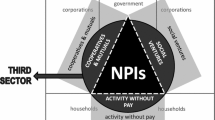Conclusion: The public choice explanation
It is apparent that comprehensive analysis requires at least some application of elementary axioms from the economics of politics (or public choice). One of these implies that, because of asymmetric costs of political participation, some suppliers of goods and services usually do better for themselves out of lobbying and organization than do others. Moreover for the same reason dispersed consumers would appear to do worst of all. Legislation and policy on nonprofit organization seems to be one of many examples of this phenomenon. In this case, however, the supply-side lobbyists are aided by an ancient and deep-seated popular prejudice against profit making. The man in the street has apparently not yet fully grasped the point that, so long as competition is possible, the profit inducement acts as a continued incentive to minimize costs. Constantly and indiscriminately to condone pejorative language against profits is to create a climate that results in legislation giving unprecedented new ‘profit’ opportunities via not-for-profit organizations. And such increased rewards can result in social harm rather than social gain. Granted there may be cases that justify nonprofits in some circumstances (Preston, 1988), the fact remains that the costs of separating and monitoring these cases, at least at federal level, would appear to be overwhelming. The nonprofit system that is usually advocated calls for a federal general tax exemption. Yet the value of this advantage is the same to all nonprofit firms whereas we need to know the extent of the particular social benefits generated in each particular case so as to give ‘tailor made’ government assistance. And since in very many instances the social benefits are negative, the government's ‘shotgun approach’ appears highly questionable.
Well expounded “invisible hand” reasoning is obviously not sufficient by itself. Adam Smith's propositions require the continual check of systematic empirical enquiry. But from the emerging results of such research on the comparative performance of nonprofit organizations, the Smithian point of view of general reliance on for-profits organization appears so far to be scoring well. Will further applied research one day begin to undermine popular prejudice against competitive as distinct from monopoly “profits”? Perhaps; but not before still more empirical enquiries on nonprofit firms have been conducted.
Similar content being viewed by others
References
Arrow, K.J. (1963). Uncertainty and the welfare economics of medical care. American Economic Review 53: 941–973.
Bays, C.W. (1979). Case-mix differences between nonprofit and for-profit hospitals. Inquiry 14: 17–21.
Clark, R. (1980). Does the nonprofit firm fit the hospital industry? Harvard Law Review 93: 1416–1489.
Danzon, P.M. (1982). Hospital ‘profits’: The effect of reimbursement policies. Journal of Health Economics, No. 1 (May): 29–52.
Easley, D. and O'Hara, M. (1983). The economic role of the nonprofit firm. Bell Journal of Economics 14: 531–538.
Fama, E. and Jensen, M. (1983). Agency problems and residual claims. Journal of Law and Economics 26 (June): 327–349.
Filer, R.K. (1986). ‘The starving artist’ — myth or reality?: Earnings of artists in the United States. Journal of Political Economy 94.1 (February): 56–75.
Filer, R.K. (September 1988). The economic condition of artists in America. Paper presented at the International Conference on Cultural Economics, Ottawa, Canada.
Frech, H.E. and Ginsberg, P. (1978). Property rights and competition in health insurance: Multiple objectives for nonprofit firms. Research in Law and Economics 3: 155–172.
Hansmann, H.B. (1983). The role of nonprofit enterprise. The Yale Law Journal 89.5 (April): 835–901.
General Accounting Office (1987). Tax policy: Competition between taxable businesses and tax-exempt organizations. Briefing Report to the Joint Committee on Taxation, U.S. Congress, GAO/GGD087-40-BR.
Hansmann, H.B. (1987). The effect of tax exemption and other factors on the market share of nonprofit versus for-profit firms. National Tax Journal 40.1 (March): 71–82.
Herzlinger, R.E. and Skrasker, W. (1987). Who profits from nonprofits? Harvard Business Review, No. 1 (February): 93–106.
Hodsoll, F. (1984). Cultural economics: The information partnership. In C. Richard Waits et al., Governments and culture. Conference Proceedings, Vol. 2, 5. Association for Cultural Economics.
Newhouse, J.P. (1970). Toward a theory of nonprofit institutions: An economic model of a hospital. American Economic Review 60: 64–74.
Pauly, M.V. (1987). Nonprofit firms in medical markets. The American Economic Review 77.2 (May): 257–262.
Preston, A.E. (1988). The nonprofit firm: A potential solution to inherent market failures. Economic Inquiry 26.3 (July): 493–506.
Sloan, F.A. (1988). Property rights in the hospital industry. In H.E. Frech (Ed.), Health care in America. Pacific Research Institute for Public Policy.
Steinberg, R. (1987). Nonprofit organizations and the market. In Walter Powell (Ed.), The nonprofit sector: A research handbook. New Haven: Yale University Press.
Schlenker, R.E. and Shaughnessy, P.W. (1984). Case mix, quality and cost relationships in Colorado nursing homes. Health Care Financing Review 6: 61–71.
Author information
Authors and Affiliations
Rights and permissions
About this article
Cite this article
West, E.G. Nonprofit organizations: Revised theory and new evidence. Public Choice 63, 165–174 (1989). https://doi.org/10.1007/BF00153398
Issue Date:
DOI: https://doi.org/10.1007/BF00153398




